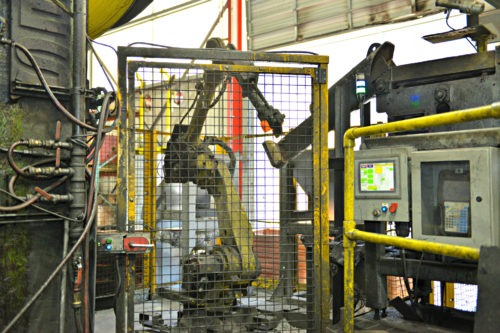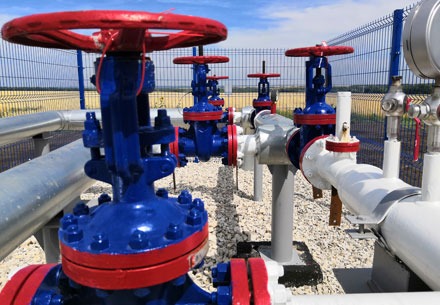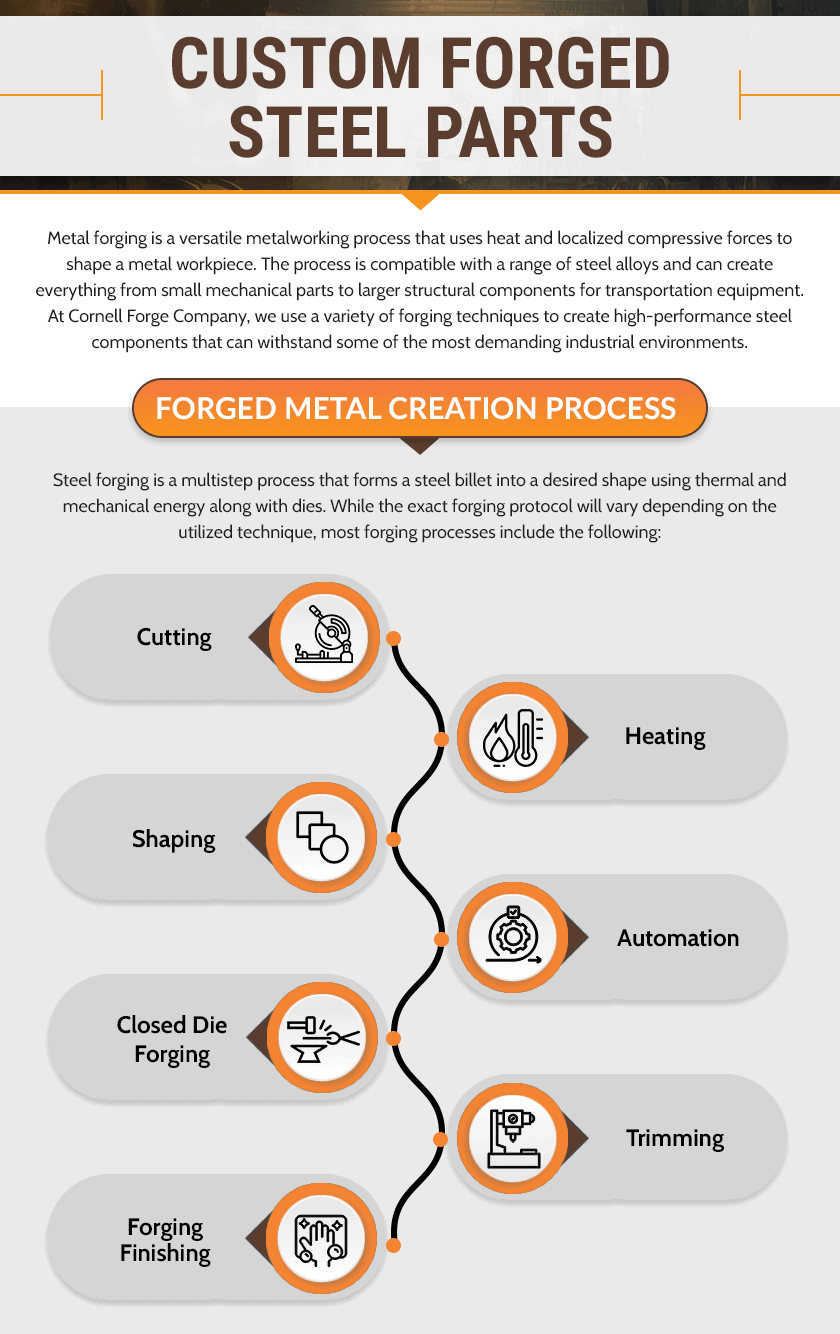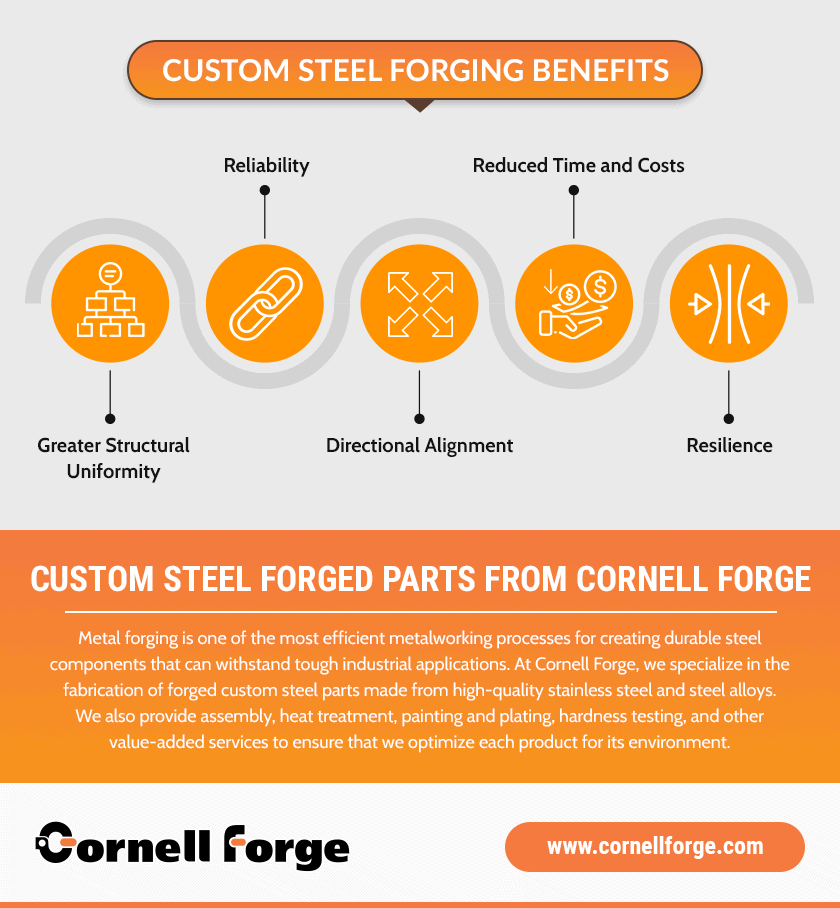Metal forging is a versatile metalworking process that uses heat and localized compressive forces to shape a metal workpiece. While the process originated several centuries ago, developments in engineering, machinery, and metallurgy have made forging one of the most effective metalworking techniques available today. The process is compatible with a range of steel alloys and can create everything from small mechanical parts to larger structural components for transportation equipment.
At Cornell Forge Company, we use a variety of forging techniques to create high-performance steel components that can withstand some of the most demanding industrial environments.
Forged Metal Creation Process

Steel forging is a multistep process that forms a steel billet into a desired shape using thermal and mechanical energy along with dies. While the exact forging protocol will vary depending on the utilized technique, most forging processes include the following:
- Cutting. With either shearing or sawing, the required billet length is cut from the steel mill-produced long bar.
- Heating. With the application of heat, the malleability of the steel workpiece increases, making it more amenable to the shaping process. The ideal forging temperature, the component’s final shape, and other factors influence the needed temperature range for forming a given steel alloy.
- Positioning. Accurate workpiece orientation and positioning are critical to a successful forging process. In most modern operations, forging manufacturers use automated processes to ensure that the hot metal workpiece reaches the lower die in the correct orientation after moving through the furnace line. For manual positioning methods, metal tongs are typically used in transferring the hot metal to the die.
- Shaping. High-pressure, controlled impact force compresses and shapes the workpiece. The type of tool an operator or machine uses to deliver the impact generally depends on the characteristics of the steel alloy. In most cases, the heated metal workpiece positions on a lower die, and a heavy ram drives an upper die into the workpiece below.
- Automation. Today, most metal forging companies incorporate some degree of automation in order to boost productivity and improve precision. For example, automated assembly lines can transfer the workpiece to each forging die during the fabrication process. At each stage, the dies’ impressions allow for the metal part’s shaping as needed to meet the design specifications.
- Closed die forging. One widely used forging method for steel is closed die forging. During this process, the hot metal workpiece compresses between two dies, forming it into the required shape utilizing a completely closed die process.
- Forging finishing. After completing the forging process, the resulting part may go through additional steps such as milling or drilling to optimize it for the intended application. Some forging processes generate flash, which must be trimmed from the final product. Finally, acid treatments, shot blasting, and other finishing techniques can create a particular surface finish.
Steel Forging
Several techniques exist for producing forged parts, each of which has specific advantages and disadvantages for certain applications. Considering everything from the steel alloy material to the shape, size, and quantity of the final product is important when determining which method will produce the best results at an acceptable cost. The three main types of steel forging are:
- Cold forging. Performed at ambient temperatures, cold forging involves compressing an unheated metal workpiece between strong dies to form the required shape in softer metals. The process is an economical one, typically resulting in parts with quality surface finishes without the need for additional finishing steps. Cold forging also provides tighter dimensional tolerances than hot forging and can produce precise parts.
- Warm forging. With warm forging, the workpiece heats to a temperature that exceeds the metal’s work hardening temperature yet remains low enough to prevent scale formation. This process leads to tighter dimensional tolerances than hot forging and increased workpiece ductility. However, warm forging is less ideal for more complex designs.
- Hot forging. Hot forging uses an extremely high temperature range that exceeds the metal’s recrystallization temperature. Operators must ensure the metal stays above a minimum temperature threshold throughout. This process increases the metal’s malleability, making it easier to form the workpiece through die pressure into complex or highly customized shapes. Hot forging also improves the final part’s grain structure. This is the forging process we use at Cornell Forge.
When working with hard metals such as steel, warm or hot forging techniques are generally preferable since cold forging increases the risk of cracking or breaking. An induction heater or gas-fired furnace heats the steel billet to the required temperature. The heated billet then goes to the die for pressing or hammering into the required shape.
Common Steel Forged Parts

The durability and resilience of steel forged parts make them key components in several applications, from aerospace and automotive systems to oil field machinery and equipment. For example, the automotive industry relies on steel forging to create hinges, brackets, engine mounts, and other critical components that can tolerate high levels of shock and stress during automobile operation.
Other common steel components created from metal forging include:
- Construction equipment
- Conveyor system components
- Crane parts
- Engine valves, couplings, cams, and crankshafts
- Exercise parts
- Firearm components
- Hand and industrial tools
- Marine components
- Mining equipment
- Pump and valve parts
- Rail and locomotive components
- Road trailer materials
- Steering arms
- Valves and fittings, both hydraulic and pneumatic
Custom Steel Forging Benefits
When creating custom steel parts, the steel forging process provides the following benefits:
- Reliability. Steel forging produces parts with close dimensional tolerances, predictable tensile strength properties, and consistent performance.
- Reduced time and costs. Forging requires less reworking of parts for shrinkage, void, or porosity issues as compared to some other metalworking processes like casting. Steel forged parts also require less machining time to finish, allowing for reduced lead times and less equipment wear and tear, giving overall cost savings.
- Greater structural uniformity. Steel forging improves the metal’s physical properties and creates a refined grain structure that conforms to the shape of the component. This enhances the finished product’s composition and mechanical strength, especially when compared to that of machined or cast metal parts.
- Directional alignment. During the forging process, the material’s metal grains undergo metallurgical recrystallization and become aligned in the direction of the metal flow. Also known as grain flow, this directional grain realignment significantly enhances the final product’s strength. Directional alignment also improves the part’s resistance to fatigue and impact.
- Resilience. Steel forging virtually eliminates the formation of internal gas pockets, cooling defects, and other structural abnormalities that can lead to sudden failure or fatigue under stress. This makes forging an ideal method for creating resilient parts that can tolerate high temperatures, heavy loads, repeated impact, and other forms of stress.
Custom Steel Forged Parts From Cornell Forge
Metal forging is one of the most efficient metalworking processes for creating durable steel components that can withstand tough industrial applications. At Cornell Forge, we specialize in the fabrication of forged custom steel parts made from high-quality stainless steel and steel alloys. We also provide assembly, heat treatment, painting and plating, hardness testing, and other value-added services to ensure that we optimize each product for its environment.
To learn more about how our custom forging solutions can solve your toughest design challenges, contact us or request a quote today.





